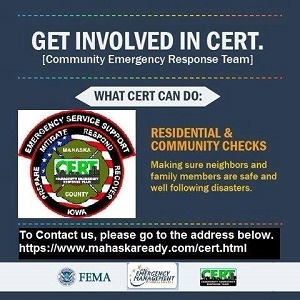Behind the Headsets – The Vital Role of Local 911 Telecommunicators

Tisha Kelderman sits at her console this past week. She is the dispatcher who answered the phone during this author’s heart attack, being that calm voice during a stressful time.
Oskaloosa – In the quiet hum of a dimly lit room inside the Mahaska County Law Enforcement Center, voices crackle through headsets. Monitors glow with incoming data. Phones ring without warning. For the community, emergencies start with a call. For telecommunicators — also known as dispatchers — that’s where the responsibility begins.
Often unseen but always essential, local 911 telecommunicators are the first link in the emergency response chain. As part of National Public Safety Telecommunicators Week, Oskaloosa News sat down with members of Mahaska County’s 911 dispatch center to better understand what it takes to wear the headset and carry the weight of every incoming call.
A Calm Voice in Chaos
“You have to multitask. You have to stay calm even when the caller isn’t,” explained Tisha Kelderman, one of Mahaska County’s highly trained 911 telecommunicators. “If you sound panicked, it makes everything worse for everyone involved.” Their tone must stay even, not just for the caller’s sake but for the safety of law enforcement and emergency crews rushing into often-volatile situations.
Dispatchers frequently relay information during high-speed pursuits, domestic disputes, structure fires, and medical crises — sometimes simultaneously. As Janel Legvold, another of Mahaska County’s highly trained 911 telecommunicators, “We had three fires going, a pursuit, and calls for helicopters — all at once. It’s just organized chaos.”
The “First” First Responders
Despite working behind the scenes, dispatchers often carry emotional weight similar to officers or EMTs. But there’s one significant difference: closure.
“We don’t always know how the story ends,” said Kelderman. “You might take a life-and-death call and never find out if the person made it.”
Their role demands detachment, but not indifference. “Sometimes you know the person calling. Or you know the street. But you can’t let that change how you respond,” Kelderman explained.
Technology and Triage
Today’s dispatching involves more than radio calls. From GPS mapping and encrypted radio systems to cell phone-based emergency alerts and text-to-911 capabilities, telecommunicators juggle a complex array of tools and protocols.
They also field nontraditional alerts, like auto-generated emergency calls from smartphones and smartwatches. “We get a lot of Apple Watch calls — sometimes from collisions, other times from accidental button presses,” Legvold shared. “You have to treat every one like it’s real until proven otherwise.”
And when those calls do come in, the team coordinates with fire departments, EMS, police, and even flight services for medical evacuations — all while continuing to answer new emergencies.
The Hidden Helpers
Mahaska’s dispatchers are more than button-pushers; they’re researchers, de-escalators, and lifesavers. Whether guiding officers through backroads only locals would know or running down details on a suspect from a vague social media post, their contribution often decides the outcome before first responders even arrive on the scene.
“We’re proud to be part of the team,” Kelderman said. “But sometimes we’re forgotten. We don’t do it for recognition, but when people remember that we’re here — that matters.”
In a small county like Mahaska, local knowledge and tight-knit teamwork add an irreplaceable dimension to the job. “Officers come in here. They know us. We’re family,” Kelderman explained.
From the routine to the life-threatening, these professionals stay ready at a moment’s notice. Their voices may never be seen, but they are always heard.
Did You Know?
You can text 911 in Mahaska County if speaking isn’t an option.
Disconnected cell phones can still dial 911, but may be harder to trace.
If your Apple or Samsung device detects a crash, it may automatically call 911.















